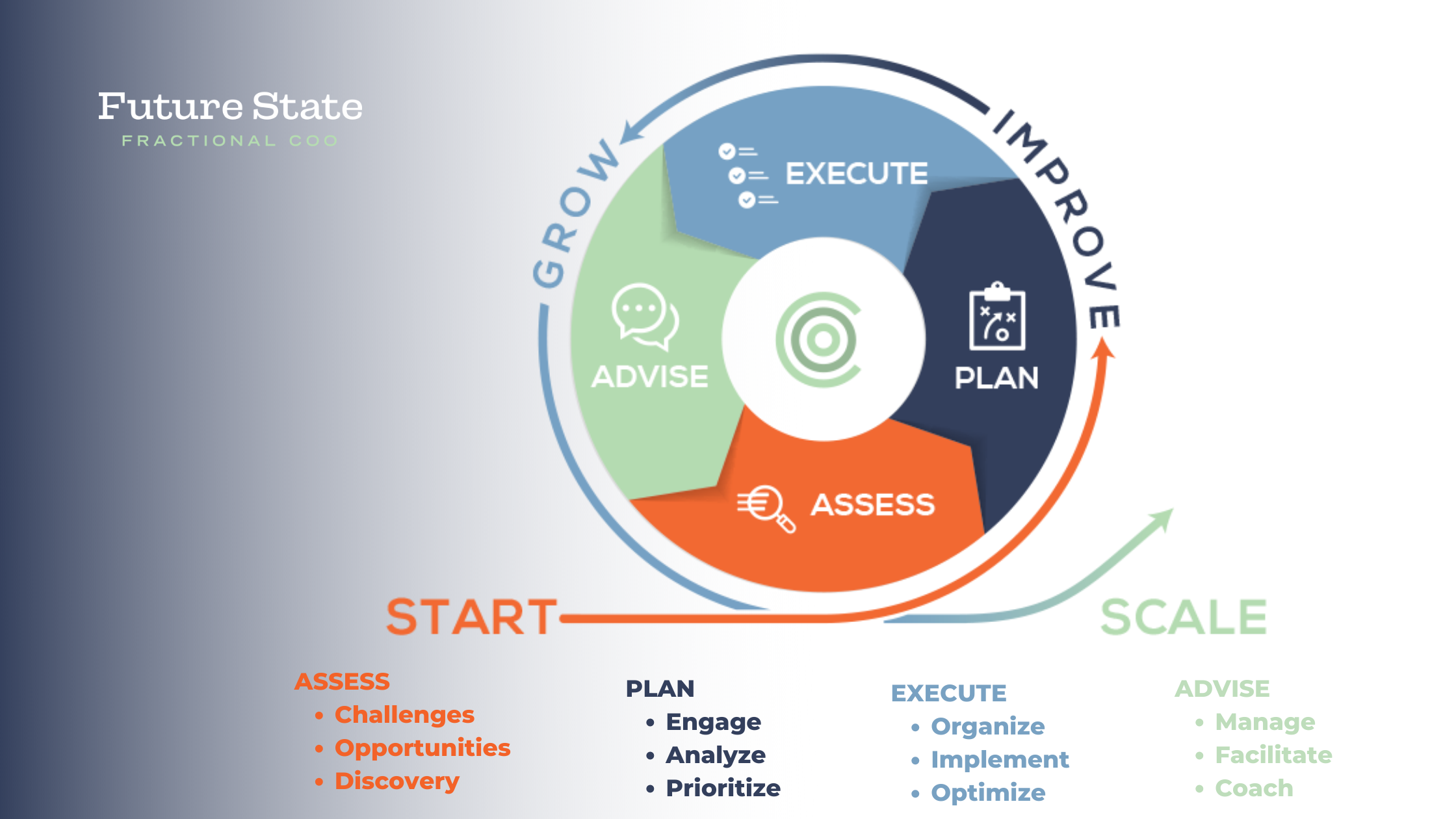The Value of Lean Business Planning (& Operationalizing Strategies with Agile)
Lean business planning does not result in a massive, multi-page document for investors or the outside world. Instead it is a system and process that results in a concise, strategic outline leveraged by management to ensure everyone is focused on the same targets, enabling people to prioritize objectives, execute on the vision, and achieve the desired future state.
What is lean business planning?
When a Fractional COO asks whether you have a lean business plan, they do not expect you to hand over a binder full of detailed descriptions, organizational steps, and investment strategies. A lean business plan is the opposite of a multi-page document meant to answer every question one might have about the business.
Lean business planning is the simple process of identifying and sharing the answers to four key questions:
What is our business strategy? Think: who you are and what you do
What are our business tactics or behaviors? Think: marketing, promoting, pricing
What is the business forecast? Think: financials, projections, market research
How do we measure success? Think: long-term goals, benchmarks, metrics
Certainly, the answers to the above questions might live in a document or binder, but the keys here are simplicity and agility. The lean business plan is a process, not a concrete set of steps.
When you have identified the critical components of your lean business plan, you can begin the process of lean business planning. Turning the individual pieces into a streamlined, cyclical process will keep your business evolving, while anchoring you to your core values, mission, and purpose.
But the true value of lean business planning lies in the way the business can be managed when the most essential elements are constantly - and consistently - monitored and adjusted. In short, the company is constantly evolving without changing its core.
Operationalize your strategies with agile.
When businesses create plans that stretch for months - even years - without a formal cycle for assessment and revision, the opportunity to make course corrections is lost. This can lead to frustration and stagnant growth, negatively affecting workplace productivity, morale, or financial health.
With agile, your lean business planning is put to good use day in and day out, and you can make adjustments to align your work to your goals on the fly. You can operationalize your strategies to ensure that the work you and your team completes is fully aligned with your lean business plan.
An agile sprint is a period of one to three weeks in which teams complete deliverables (called stories) that are outlined at the beginning of the sprint. Rather than stemming from the ether or what seems to be the right next step, these stories are created from the end user’s perspective to define what’s needed to bring a product to life.
Agile Planning in Action
Without an agile approach, the strategic planning process might look something like this:
You (a team leader, business owner, or CEO) defines a problem that needs to be solved and leads the team to ideate a solution.
You assign tasks to relevant people that will take the solution from idea to production.
In this process, all the onus for creativity, problem-solving, project management, idea-generating, and production management falls onto the shoulders of one person: You.
The result can be a mix of success and failure, with little to no feedback until your planned solution is produced in the real world.
With an agile approach, the strategic planning process is focused, clear, and rhythmic, like a dance where you leverage the genius within your team.
You (a team leader, business owner, or CEO) defines a problem that needs to be solved.
You bring the problem to your team, which ideas a solution based on the needs of the user - or the team member, in the case of internal projects.
You lead your team and various roles through the following cycle:
Ideate - the team defines the next proper steps as those needed by the end-user
Iterate - the team iterates solutions that best fit the problem with real-time adjustments and planning
Produce - the team defines tasks, assigns responsibilities, and designates points (specifically in the Scrum approach), then completes each task
Release - the product is released into the real world
Reflect - retrospective meetings are held to identify the strengths and areas for growth of previous work so that they can be immediately applied to the next round of work
One of the biggest boons to this type of planning is that the team members doing the work are the ones defining the scope, sequence, and time periods it will take to complete the work.
This process leaves you as a leader or business owner in your zone of genius, whether leading people, seeking new clientele, or holding the organization to the values and vision you have defined.
Put theory into practice.
A clear vision of what success looks like provides a roadmap for everyone in your organization.
This is where defining your non-negotiable values and guiding principles Working from the non-negotiable end goals you specify, you enable clarity and accountability every step along the way.
One of the final elements of lean business planning that will maximize your efforts to systematize your operations is Rocks.
Rocks are clearly defined, measurable goals that individual team members are accountable for completing in 90-day increments.
It is possible to prioritize where you and your organization focus your resources and live in an agile 90-day world. You know thatyoure actions this week will drive success this quarter, what you accomplish this quarter will drive success for the year, and what you create year after year is aligned to your organization’s purpose, values, and principles.
Rocks help you achieve your vision of success by mapping that success onto individual goals and individual people.
It is important to remember that focused action does not mean taking the straight, linear path toward a single, unmovable goal.
Instead, the yogic power of Drishti teaches you to stop, breathe, and bring all your attention to the one thing in front of you – even as you get distracted, begin to wobble, or let your eyes and mind wander.
Locking your gaze on something solid and stable makes it easier to balance.
Remaining focused on the organization’s non-negotiables, core values, and guiding principles will make that balance possible and determine the right course of action.
If you are ready to operationalize, simplify, and define your organization’s strategy for success, but unsure of the roadmap to take, you are looking for a seasoned Fractional COO. Let’s have a conversation- quick, easy, no strings attached.




